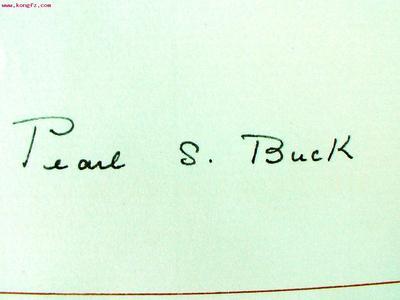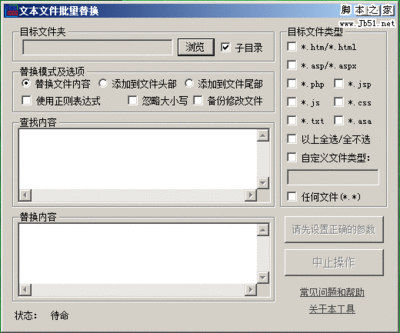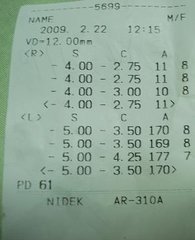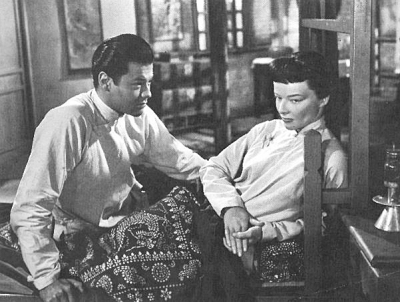One of the most popular American authors of her day,humanitarian, crusader for women's rights, editor of Asiamagazine, philanthropist, noted for her novels of life in China.Pearl S. Buck was awarded the Nobel Prize for Literature in 1938.The decision of the Swedish Academy stirred controversy, especiallyamong critics who believed that Buck lacked the stature the NobelPrize was intended to confirm. Nowadays Buck's books are generallyconsidered dated although attempts have been made to rehabilitateher work. "One does not live half a life in Asia without return. When itwould be I did not know, nor even where it would be, or to whatcause. In our changing world nothing changes more than geography.The friendly country of China, the home of my childhood and youth,is for the time being forbidden country. I refuse to call it enemycountry. The people in my memory are too kind and the land toobeautiful." (from A Bridge for Passing, 1963) Pearl S. Buck was born in Hillsboro, West Virginia. She spenther youth in China, in Chinkiang on the Yangtse River. She learnedto speak Chinese before she could speak English. Her parents weremissionaries. Buck's father, Absalom Sydenstricker, was ahumorless, scholarly man who spent years translating the Bible fromGreek to Chinese. Her mother, the former Caroline Stulting, hadtravelled widely in her youth and had a fondness for literature.Buck's life in China was not always pleasant. When she was only achild, the family was forced to flee from the rebel forces of theBoxer Rebellion. After being educated by her mother and by a Chinese tutor, whowas a Confucian scholar, Buck was sent to a boarding school inShanghai (1907-09) at the age of fifteen. She also worked for theDoor of Hope, a shelter for Chinese slave girls and prostitutes.Buck continued her education in the United States at Randolph-MaconWoman's College in Virginia, where she studied psychology. Aftergraduating in 1914, she returned to China as a teacher for thePresbyterian Board of Missions. Her mother was seriously ill andBuck spent two years taking care of her. Buck married Dr. John Lossing Buck, an agricultural expert,devoted to his work. When her mother recovered, they settled in avillage in the North China. Buck worked as a teacher andinterpreter for her husband and travelled through the countryside.During this period China took steps toward liberal reform,especially through the May4th Movement of 1917 to 1921. In the 1920s the Bucksmoved to Nanking, where she taught English and American literatureat the university. In 1924 she returned to the United States toseek medical care for her first daughter, who was mentallyretarded. In 1926 she received her M.A. in literature from CornellUniversity. The Bucks went back to China in 1927. During the civil war, theywere evacuated to Japan - Buck never returned to China. In 1935Buck divorced her first husband and married her publisher and thepresident of John Day Company, Richard Walsh, with whom she movedto Pennsylvania. As a writer Buck started with the novel EAST WIND: WEST WIND(1930), which received critical recognition. She had earlierpublished autobiographical writings in magazines and a storyentitled 'A Chinese Woman Speaks' in the Asia Magazine. Herbreakthrough novel, THE GOOD EARTH, appeared in 1931. Its style, acombination of biblical prose and the Chinese narrative saga,increased the dignity of its characters. The book gained a wideaudience, and was made into a motion picture.  In 1936 Buck was made a member of the National Institute of Artsand Letters. She became in 1938 the third American to win the NobelPrize in Literature, following Sinclair Lewis and Eugene O'Neill.In 1951 she was elected to the American Academy of Arts andLetters. During World War II she lectured and wrote on democracyand American attitudes toward Asia. Through her personalexperiences, Buck had much first-hand knowledge of therelationships between men and women from different cultures. In herbooks one of the major themes was interracial love. In THE ANGRYWIFE (1949) she wrote about the love of Bettina, a former slave,and Tom, a southerner who fought for the army of the North. In THEHIDDEN FLOWER (1952) a Japanese family is overset when the daughterfalls in love with an American soldier. Buck and Walsh were active in humanitarian causes through theEast and West Association, which was devoted to mutualunderstanding between the peoples of Asia and the United States,Welcome House, and The Pearl Buck Foundation. A friend of EleanorRoosevelt, Margaret Mead, and Paul Robeson, she also advocated therights of women and racial equality before the civil rightsmovement. As a consequence of these activities, the F.B.I. keptdetailed files on her for years. After the communist revolution in China, Buck becamedisillusioned about the chances for international cooperation. THEPATRIOT (1939) focused on the emotional development of anuniversity student, whose idealism is crushed by the brutalities ofwar. Buck gradually shifted her activities to a lifelong concernfor children. She coined the word ''Amerasian'' and raised millionsof dollars for the adoption and fostering of Amerasian children,often abandoned by their American fathers stationed in the FarEast. Buck's own family included nine adopted children as well asher biological daughters. THE CHILD WHO NEVER GREW (1950) told apersonal story of her own daughter, whose mental developmentstopped at the age of four. The subject is also dealt with inBuck's famous novel The Good Earth. The book was filmed in1937. Irving Thalberg had wanted to produce the novel since the1931 publication. Thalberg employed many Chinese as extras andauthentic background shots were made in China. Luise Rainer won anAcademy Award for best actress. Buck did not first complain hersmall royalty, until years later, when MGM ignored her plea for asubstantial donation to help Amerasian children. The Good Earth (1931) sold 1,800,000 copies in its firstyear. It has been translated into more than thirty languages andwas awarded the Pulitzer Prize for fiction in 1932. The storyfollows the life of Wang Lung, from his beginnings as animpoverished peasant to his eventual position as a prosperouslandowner. Wang Lung collects a slave, O-lan, from the prosperoushouse of Hwang. O-lan's parents sold her to Hwang because they werepoor and needed money. According to an old Chinese custom, WangLung's and O-lan's marriage is pre-arranged. The fiancée is notbeautiful, she is humble but shares with him the devotion to land,to duty, and to survival. First year is happy: the crop is good andthey have two sons. Then the crops fail, and O-lan gives birth to agirl. The family moves to south, and the man abandons the plan tosell the child. Revolution breaks out, houses are plundered, andWang Lung gets in his possession a silver treasure. The familyreturns to their home region. Wang Lung buys land and soon ownsalso the house of now impoverished Hwang. The only problem is theirretarded child, a girl, who don't speak. O-lan gives birth totwins, a boy and a girl. The elder boys go to school. Wang Lungbuys another wife, Lotus. O-lan is not well after the birth of thetwins, and she dies after the wedding of her sons. In his old days,Wang Lung gives his love to a young slave girl, who also takes careof the retarded girl. His youngest son moves from the house tobecome a soldier and because he also loves the young slave girl.Old Wang Lung witnesses for his sorrow that his children do notshare his unyielding devotion to the land. - The novel was followedby two sequels, SONS (1932), which focused on the youngest son,Wang the Tiger, and A HOUSE DIVIDED (1935), which was Yuan's story.The three novels were published in 1935 in one volume as THE HOUSEOF EARTH. At her death Buck was working on 'The Red Earth', afurther sequel to The Good Earth, presenting the modern-daydescendants of that novel's characters. After Walsh's death, Buck formed a relationship with Ted Harris,a dance instructor 40 years her junior, who took charge of thePearl S. Buck Foundation. Buck died at the age of eighty in Danby,Vermont, on March 6, 1973. Her manuscripts and papers are at thePearl S. Buck Birthplace Foundation, Hillsboro, West Virginia andthe Lipscomb Library of Randolph-Macon Women's College, Lynchburg,Virginia. "I feel no need for any other faith than my faith in humanbeings, Buck said in 1939. "Like Confucius of old, I am so absorbedin the wonder of earth and the life upon it that I cannot think ofheaven and the angels... If there is no other life, then this onehas been enough to make it worth being born, myself a human being."During her career as an author, spanning forty years, Buckpublished eighty works, including novels, plays, short storycollections, poems, children's books, and biographies. She alsowrote five novels under the name John Sedges and translated LoGuangzhong's (1330-1400) The Water Margin / Men of theMarshes, which appeared in 1933 under the title All Men AreBrothers. The book depicts adventures of outlaws and was bannedby Sung rulers. COMMAND THE MORNING (1959) concerned the efforts ofthe Manhattan Project to develop the atomic bomb and the ethics ofdropping it on Japan. THE CHINESE NOVEL (1939) was largely anexplanation of her own writing style. For further reading: Pearl S. Buck by Kang Liao (1997);Pearl S. Buck: A Cultural Biography by Peter Conn (1996);World Authors 1900-1950, ed. by M. Seymour-Smith and A.C.Kimmens (1996); The Several Worlds of Pearl S. Buck, ed. byElizabeth J. Lipscomb (1994); Pearl S. Buck: Good EarthMother by W. Sherk (1992); Pearl Buck. A Woman inConflict by N.B. Stirling (1989); Pearl S. Buck: The FinalChapter by Beverly E. Rizzon (1988); The Lives of PearlBuck by I. Block (1973); Pearl S. Buck by P. Doyle(1980; Pearl S. Buck: A Biography by T. Harris (1971);Pearl S. Buck by T.F. Harris (1969); Pearl S. Buck byP.A. Doyle (1965); The Image of the Chinese Family in PearlBuck's Novels by C. Doan (1964) - Other film adaptations:China Sky, 1945, dir. by Ray Enright, starring RandolphScott, Ellen Drew Selected works: |
赛珍珠(Pearl S. Buck或PearlBuck,1892年6月26日—1973年3月6日),美国作家。1932年借其小说《大地》(The GoodEarth),成为第一位获得普利策小说奖的女性;1938年获诺贝尔文学奖。她也是唯一同时获得普利策奖和诺贝尔奖的女作家,作品流传语种最多的美国作家。
作品
《桥》(A Bridge for Passing)
《来吧,亲爱的》(Come, My Beloved)
《命令与清晨》(Command the Morning)
《东风:西风》(East Wind: West Wind)
《流亡》(The Exile)
《搏斗的天使》(Fighting Angel)
《十四个故事》(Fourteen Stories)
《群芳庭》(Pavilion of Women)
《大地》(The Good Earth)上海译文出版社 2002 ISBN 7532729273
《归心》和其它故事(Hearts Come Home and Other Stories)
《匿花》(The Hidden Flower)
《帝国女性》(Imperial Woman)
《北京来信》(Letter from Peking)
《生芦苇》(The Living Reed)
获奖
1932年,普利策小说奖
1935年,威廉·迪·豪威尔勋章
1938年,诺贝尔文学奖
赛珍珠(1892-1973)女。出生于美国弗吉尼亚州,3个月时即被身为传教士的双亲带到中国。在双语环境中长大,是以中文为母语之一的著名美国作家。曾回美四年接受高等教育。自1919年至1935年,她与丈夫卜凯(J. L. Buck) 长期居住在所执教的金陵大学分配给他们的两层楼房里。在这里她写出了于1938年荣获诺贝尔文学奖的长篇小说《大地(Gread Earth)三部曲》等小说,并最早将《水浒传》翻译成英文在西方出版。一生著译作品70余部。她病逝后,按其遗愿,墓碑上只镌刻“赛珍珠”三个汉字。
反对传教的教师
1919年下半年,赛珍珠随丈夫卜凯来到南京,受聘于美国教会所办的金陵大学,并住进了校内一幢单门独院的小楼。在赛珍珠和卜凯三、四十年代先后离开中国之前,一直居住在这里(即今平仓巷5号)。卜凯(J.L.Buck)是一位农学家,教授农业技术和农场管理的课程,创办了金大农业经济系并任系主任,因出版《中国农家经济》等书而被视为美国的中国问题专家。赛珍珠则在金陵大学外语系任教,并先后在东南大学、中央大学等校兼职教授教育学、英文等课。她既要备课、批改作用,又要参与社会工作,会见中外各界人士,还要修剪家中花园的大片花草,忙得不亦乐乎。在举行孙中山奉安大典期间,赛珍珠即在家中腾出地方,让中国驻美大使施肇基博士和为孙中山遗体作防腐处理的泰勒博士住了进来。徐志摩、梅兰芳、胡适、林语堂、老舍等人都曾是她家的座上客。
赛珍珠最喜欢教的课是英文,因为这门课有着极大的发挥空间,可以充分“表现”她的渊博学识和过人的口才。当然也曾有学生认为她上英文课是“海阔天空,离题万里”而告到了校长室去。她自认为“上得较为逊色”的是宗教课。在给纽约传教董事会的工作汇报中,赛珍珠直言不讳地说:“对在课堂上传授宗教知识的整套方法,我深表不满。”她认为“和正规的宗教课相比,在教育学课上传授宗教知识则更胜一筹”。这引起了董事会的不满,董事会很不客气地告诫赛珍珠:“只有正规地传授神学才算正道。”赛珍珠没有屈服于压力,在力争无效的情况下,愤而辞去了宗教课的教职。对此,陈裕光校长和许多外籍教师都深感惋惜。但是在中国、美国许多地方,赛珍珠都仍然公开声称她极为讨厌那些“喋喋不休的布道”,说布道只会“扼杀思想,蛊惑人心,在中国教会里制造出一批伪君子”。她认为,“空谈无益,基督徒应该给中国人提供实实在在的服务,譬如教育、医疗和卫生”。
把《水浒传》推向世界的第一人
中国古典文学名著《水浒传》迄今已有多种外文译本,有的直译成《发生在水边的故事》,有的意译为《一百零五个男人和三个女人》。在所有译作中,翻译得最为准确、最为精彩也是最有影响的,还当数它的第一个英译本——《四海之内皆兄弟》。这个英译本便出自赛珍珠的笔下。
赛珍珠精通汉语,对中国小说有着极高的评价。她在诺贝尔奖授奖仪式上的致谢词便是以《中国小说》为题的,她说:中国的古典小说与“世界任何国家的小说一样,有着不可抗拒的魅力”,“一个真正受过良好教育的人,应该知道《红楼梦》、《三国演义》这样的经典之作”。她的这番话赢来了文学大师们的热烈掌声,因为她在数年之前翻译的《水浒传》在西方的流行,已经让人们对中国小说刮目相看了。
赛珍珠翻译《水浒传》还是20年代中后期的事情,当时南京出售着《水浒传》的好几个版本,有的只有七十回,有的长达一百二十回。赛珍珠选择的是七十回本的《水浒传》,她认为这个版本最好,因为较长的版本结尾大多是好汉们被朝廷招安,而七十回本则自始至终贯穿着与官府反抗到底的思想。
赛珍珠之所以选定《水浒传》来翻译,既有艺术上的考虑,也有“政治上”的因素。《水浒传》的口语化文字对中国小说史具有深远的影响,赛珍珠对这种文字风格很是赞赏。而小说的政治内容对她的吸引力则更大。她十分清楚,“中国历史上的起义人士不管属于哪一种人,也不论他们持有什么信仰,无一不喜欢《水浒传》,毛泽东就是其中之一”。她也听说过这样一个笑话:在首都南京有好事者散布谣言说,农民运动正在传播一首革命歌谣,诉说农民生活的艰辛:“烈日炎炎似火烧,野田禾苗半枯焦。农夫心内如汤煮,公子王孙把扇摇。”后来一查才发现原来它不是“马克思主义歌谣”,而是《水浒传》上的一首诗。所以,赛珍珠认为小说的主要矛盾是“老百姓和腐败的官府之间的斗争”。在赛珍珠眼里,梁山一百单八将类似于英国中世纪追随罗宾汉的绿林英豪,他们并非存心造反,只是受环境逼迫,万般无奈之下才揭竿而起的;他们是足智多谋、骁勇善战的公民,所反抗的是邪恶的势力和无道的社会。
在这段时间,赛珍珠除了教学之外,就是埋头翻译《水浒传》。前后耗时五年,终于将《水浒传》翻译成了一千多页的英文。而书的原名“水浒”通常被译成“WaterMargin”,指的是书中许多事件的发生地。赛珍珠认为书名这样去译,西方读者肯定不知所云,她先后试用过《侠盗》、《义侠》等名,但自己都不甚满意。直到出版前不久,她才突来灵感,想到了《论语》中的一句名言:“四海之内,皆兄弟也。”于是在纽约庄台公司1933年出版这本上、下两卷的译著时即以AllMen AreBrothers为名。这是《水浒传》的第一个英文全译本,在美国很是畅销,从中国杀将过去的这批“梁山好汉”,一下子就“窜”上了美国权威的“每月图书俱乐部”的排行榜。
诞生于中国《大地》的诺贝尔文学奖
1938年度诺贝尔文学奖的获得者是一位女士——获奖作品是中国题材的《大地三部曲》、《异邦客》和《东风·西风》。这位“对中国农民生活进行了史诗般的描述”,“为中国题材小说作出了开拓性贡献”的获奖者就是赛珍珠,曾经在金陵大学执教的美国人PearlBuck。而她的所有获奖作品也大都是她在金陵大学一边教书、一边创作写成的。
赛珍珠开始写作生涯时,适逢一场不同寻常的世界性文化风潮。她读过陈独秀、胡适等人在《新青年》上发表的文章。对于中国的新文化运动,她认为这是“现代中国的一股新生力量”,将会释放出“被压抑了许多世纪的能量”。她谙熟汉语,对中国古典文学所知甚多,又和新文化运动中的人物接触频繁,这都有利于她对周围掀起的风暴作出判断。于是她便在平仓巷5号小阁楼的窗台下,摆放一架打字机,面对紫金山,沉入了对作品的构思之中。
1923年赛珍珠写出了处女作《也在中国》,此后便屡屡有作品发表。1927年春北伐军攻克南京时,社会失去了控制,对于许多外国人来说真是危机四伏,所以她沦落为“洋难民”,离开了南京。当1928年夏回到南京的家园时,尽管整座院落成了马厩和“公厕”,但她却在一个小壁橱里惊喜地翻出一个木箱。士兵和劫匪掠走了她的大半家产,却把这个木箱留了下来,箱中完好无损地放着她在母亲去世后为其写的《凯丽的传记》一书的手稿——这部手稿排成铅字时书名便改成了《异邦客》。赛珍珠继续创作,不久给美国的朋友戴维·劳埃德寄去了一篇曾经在杂志上发表的小说《一位中国女子说》,同时还附上了未曾发表的续篇,建议将两者合成一部长篇,书名定为《天国之风》。
戴维·劳埃德接到《天国之风》的书稿后,分别寄给了20多个出版社,纽约的庄台公司总裁理查德·沃尔什慧眼识珠,很快便决定出版赛珍珠的《天国之风》,只是将书名定为《东风·西风》。
不久赛珍珠的新作《王龙》又从南京金陵大学寄到了纽约庄台公司,沃尔什又热情地答应出版,只是觉得《王龙》之名很难为人接受,而书名应“扣人心弦,富有浪漫情调”,建议改用“大地”之类的名字。1931年春,装帧精美的《大地》(GreadEarth)出版,好评如潮,销量飙升,《大地》一下子成了1931年和1932年全美最畅销的书。并且,很快就有了德文、法文、荷兰文、瑞典文、丹麦文、挪威文等译本。庄台公司也因此从一个负责累累的出版社一跃而成为纽约著名的出版公司。沃尔什与赛珍珠双方还愉快地订下并切实履行了这样的协议:赛珍珠写什么,他就出什么。所以赛珍珠后来写成的《大地三部曲》之《儿子们》、《分家》以及其他多种文学作品,都是由沃尔什的公司出版的。
 爱华网
爱华网


